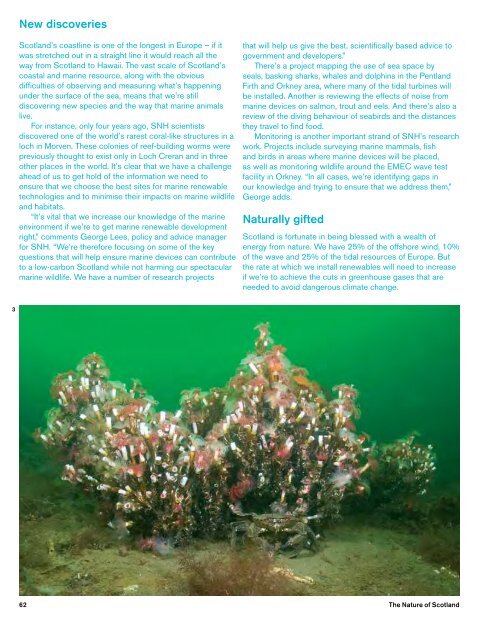Create successful ePaper yourself
Turn your PDF publications into a flip-book with our unique Google optimized e-Paper software.
New discoveries<br />
<strong>Scotland</strong>’s coastline is one <strong>of</strong> the longest in Europe – if it<br />
was stretched out in a straight line it would reach all the<br />
way from <strong>Scotland</strong> to Hawaii. <strong>The</strong> vast scale <strong>of</strong> <strong>Scotland</strong>’s<br />
coastal and marine resource, along with the obvious<br />
difficulties <strong>of</strong> observing and measuring what’s happening<br />
under the surface <strong>of</strong> the sea, means that we’re still<br />
discovering new species and the way that marine animals<br />
live.<br />
For instance, only four years ago, SNH scientists<br />
discovered one <strong>of</strong> the world’s rarest coral-like structures in a<br />
loch in Morven. <strong>The</strong>se colonies <strong>of</strong> reef-building worms were<br />
previously thought to exist only in Loch Creran and in three<br />
other places in the world. It’s clear that we have a challenge<br />
ahead <strong>of</strong> us to get hold <strong>of</strong> the information we need to<br />
ensure that we choose the best sites for marine renewable<br />
technologies and to minimise their impacts on marine wildlife<br />
and habitats.<br />
“It’s vital that we increase our knowledge <strong>of</strong> the marine<br />
environment if we’re to get marine renewable development<br />
right,” comments George Lees, policy and advice manager<br />
for SNH. “We’re therefore focusing on some <strong>of</strong> the key<br />
questions that will help ensure marine devices can contribute<br />
to a low-carbon <strong>Scotland</strong> while not harming our spectacular<br />
marine wildlife. We have a number <strong>of</strong> research projects<br />
that will help us give the best, scientifically based advice to<br />
government and developers.”<br />
<strong>The</strong>re’s a project mapping the use <strong>of</strong> sea space by<br />
seals, basking sharks, whales and dolphins in the Pentland<br />
Firth and Orkney area, where many <strong>of</strong> the tidal turbines will<br />
be installed. Another is reviewing the effects <strong>of</strong> noise from<br />
marine devices on salmon, trout and eels. And there’s also a<br />
review <strong>of</strong> the diving behaviour <strong>of</strong> seabirds and the distances<br />
they travel to find food.<br />
Monitoring is another important strand <strong>of</strong> SNH’s research<br />
work. Projects include surveying marine mammals, fish<br />
and birds in areas where marine devices will be placed,<br />
as well as monitoring wildlife around the EMEC wave test<br />
facility in Orkney. “In all cases, we’re identifying gaps in<br />
our knowledge and trying to ensure that we address them,”<br />
George adds.<br />
Naturally gifted<br />
<strong>Scotland</strong> is fortunate in being blessed with a wealth <strong>of</strong><br />
energy from nature. We have 25% <strong>of</strong> the <strong>of</strong>fshore wind, 10%<br />
<strong>of</strong> the wave and 25% <strong>of</strong> the tidal resources <strong>of</strong> Europe. But<br />
the rate at which we install renewables will need to increase<br />
if we’re to achieve the cuts in greenhouse gases that are<br />
needed to avoid dangerous climate change.<br />
3<br />
62 <strong>The</strong> <strong>Nature</strong> <strong>of</strong> <strong>Scotland</strong>

















